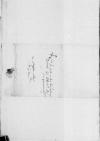Cum Vestra Reverendissima Dominatio mihi suo mandato ⌊⌋, ut gratias agerem domino ⌊Rudolpho de Höhnfeld⌋, quia recepisset eam in domum suam etc. sollicitaremque, ut canem illum Anglicum deperditum acquireret[1], feci utrumque. Et primum quidem antequam haberem ⌊⌋ Vestrae Reverendissimae Dominationis, quia cum ipse hanc receptionem mihi narrabat, dixi illi in hominem gratum beneficium hoc contulisse, cum denique litterae illae mihi praesentatae et in praesentia sua eas legi. De cane autem ego egi, quae potui, et hospes ille diu dubitabat, an mihi illum mitteret, cum haberet a Vestra Reverendissima Dominatione in mandatis domino Rudolpho praesentare. Quem tamen antea miserat usque ⌊Olomuncium⌋ post Vestram Reverendissimam Dominationem proprio nuntio, ut ipse asserit. Atque ita vicesima praesentis mensis missus est ille canis. Quem Vestrae Reverendissimae Dominationi praesenti nuntio mitto supplicando, ut hanc moram meae negligentiae non imputet, sum enim cupidissimus Vestrae Reverendissimae in omnibus obsequi, nollem etiam ingratus notari[2].
Quae[3] autem apud nos aguntur, nollem quoque Vestram Reverendissimam Dominationem latere. ⌊Turcus⌋ ⌊Guncium⌋ obsidet quasi decem octo diebus[4], ignobile oppidum, nec causam possumus scire, cur suam potentiam illuc converterit; est quidem unum ex oppidis, quod ⌊Fridericus Imperator Tertius⌋ ex manibus praedonum[5] ⌊Austriam⌋ devastantium eripuerat[6] et intra fines ⌊Hungariae⌋ hodie situm est. Forte ob commeatum illic inductum et exercitus suus fame premitur, utique ante biduum non potiebatur illo. Praeest illi strenuus eques ⌊Nicolaus Iurasitz Croatus⌋, qui ante paucos annos oratorem apud ⌊Turcum⌋ agebat[7].
Nos illic obsidionem expectabamus et videmus frustra, provisi omnibus ferme necessariis. Forte ob id consilium mutavit, et cum falsus sit, sperans omnem Christianitatem in discordia et imperium ac ⌊Germaniam⌋ in tumultu offensurum.
 UUB, H. 154, f. 89v
UUB, H. 154, f. 89v
Illustrissimus dux ⌊Fridericus comes palatinus Rheni⌋[8] vicesima praesentis venit usque ⌊Khärneuburg⌋ oppidum duobus miliaribus ab hinc. Quem die sequenti suscepimus – ipse heri huc venit et rediit. Meo iudicio omnes copias imperii[9] nunc in utraque ⌊Austria⌋[10] esse. Coniungemus nostros exercitus, usque ⌊caesaris⌋ copiae venient, quae et paucis diebus venturae sunt[11]. Tandem exsequemur voluntatem Dei nostri.
Dominus ⌊Petrus de la Cueva⌋, commendator vel granmaestro sui ordinis et magister curiae caesareae, orator[12] una cum duce advenit. Pro certo refert dominum Anthonium ⌊Andream de Orio⌋[13] caesarea classe ⌊Bisantium⌋ versus navigasse. Quae omnia Omnipotens dirigat sua gratia, Vestrae Reverendissimae Dominationi det sanitatem et omnem felicitatem. Quae me sua solita gratia prosequatur.



 UUB, H. 154, f. 90v
UUB, H. 154, f. 90v